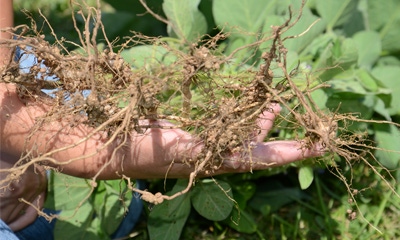
There are many reasons why soybeans could be off to a slow start. Odds are weather is playing a role somewhere in the mix. Here is a five-step process that a team of agronomists put together that could help you isolate the cause, and determine if you can do anything.
The team includes Jamie Bultemeier, agronomist with A&L Great Lakes Labs, Fort Wayne; Gene Flaningam, independent crops consultant, Vincennes; and Bryan Overstreet, Purdue University Extension ag educator in Jasper County. All three are Indiana certified crop advisers.
Step 1: Dig up a few plants in good fields and slower-growing fields.

HEALTHY NODULES: Here is what you want — lots of healthy nodules on the roots, helping supply N to the plant. You won’t find this many nodules on small plants. Those that you do find should be pink inside.
“Look for presence, size and color of nodules on the soybean plants,” Bultemeier says. “Healthy and active nodules are pink when split open. “
Step 2: Tie in tissue sampling.
Start with observations of the roots, and then move to plant tissue samples to determine relative nitrogen content in the plants, Bultemeier says. If these observations and test results indicate a problem with nodules or nitrogen levels, move to step 3.
Step 3: Determine soil pH levels.
Soybean nodulation can be slowed if pH is outside the range of 5.5 to 8, Bultemeier says. Refer back to your most recent soil tests on fields where you observe slow growth, or pull new soil samples.
Step 4: Determine if heavy residue or weather conditions are playing a role.
“It may be more to do with some fields having heavier residue than other fields,” Overstreet says. “Those soils will be cooler and slow down natural release of N. A higher carbon-to-nitrogen ratio will also slow down release of N. Plants should start producing N at V2 to V3.”
Step 5. Determine if you need to stimulate them with added nitrogen.
Spray with a diluted N solution, Overstreet says. Apply no more than 28 pounds of N per acre, or nodules may start shutting down.
Flaningam suggests broadcasting dry urea with a spinner to stimulate slow-growing plants. However, he also urges you to consider economics before you decide to apply N.
About the Author(s)
You May Also Like




